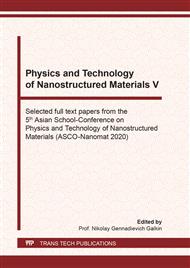[1]
N. V. Sidorov, T. R. Volk, B. N. Mavrin, V. T. Kalinnikov, Lithium Niobate: Defects, Photorefraction, Vibrational Spectra, Polaritons, Nauka, Moscow, 2003. (In Russian).
Google Scholar
[2]
Yu. S. Kuzminov, Electro-optical and nonlinear-optical lithium niobate crystal, Nauka, Moscow, 1987. (In Russian).
Google Scholar
[3]
V. Ya. Shur, A. R. Akhmatkhanov, I. S. Baturin, Micro- and nano-domain engineering in lithium niobate, Appl. Phys. Rew. 2, 4 (2015) 040604-0406015. https://doi.org/10.1063/1.4928591.
DOI: 10.1063/1.4928591
Google Scholar
[4]
K. Lengyel, A. Peter, L. Kovacs, G. Corradi, L. Palfavi, J. Hebling, M. Unferdorben, G. Dravecz, I. Hajdara, Zs. Szaller, K. Polgar, Growth, defect structure, and THz application of stoichiometric lithium niobate, Appl. Phys. Rew. 2 (2015) 040601-040628. doi.org/10.1063/1.4929917.
DOI: 10.1063/1.4929917
Google Scholar
[5]
R.N. Balasanyan, E. S. Vartanyan, V. T. Gabrielyan, L.M. Kazaryan, A method of growing lithium niobate crystals. Auth. certificate №845506 from 06.03.81 Priority from 233.03.79. Open Publishing Formula 27.02.2000. (In Russian).
Google Scholar
[6]
M. N. Palatnikov, N. V. Sidorov, Some fundamental points of technology of lithium niobate and lithium tantalite single crystals, In: Oxide electronics and functional properties of transition metal oxides, NOVA Sience Publichers, USA, 2014, pp.31-168.
Google Scholar
[7]
M. N. Palatnikov, I. V. Biryukova, N. V. Sidorov, A. V. Denisov, V. T. Kalinnikov, P. G. R. Smith, V. Ya. Shur, Growth and concentration dependencies of rare-earth doped lithium niobate single crystals, J. Cryst. Growth. 291 (2006) 390-397.
DOI: 10.1016/j.jcrysgro.2006.03.022
Google Scholar
[8]
M. N. Palatnikov, N. V. Sidorov, I. V. Biryukova, O. B. Shcherbina, V. T. Kalinnikov, Graned charge for growth of lithium niobate single crystals, Perspekt. Mater. 2 (2011) 93-97. (In Russian).
DOI: 10.1080/10584587.2011.570678
Google Scholar
[9]
N. V. Sidorov, M. N. Palatnikov, N. A. Teplyakova, A. V. Syuy, E. O. Kile, and D. S. Shtarev, Photoelectric Fields and Band Gap in Doped Lithium Niobate Crystals, Inorg. Mater. 54, 6 (2018) 581-584. doi 10.1134/S0020168518060134.
DOI: 10.1134/s0020168518060134
Google Scholar
[10]
M. H. J. Emond, M. Wiegel, G. Blasse, R. Feigelson, Luminescence of stoichiometric lithium niobate crystals, Mat. Res. Bull. 28, 10 (1993) 1025-1028. https://doi.org/10.1016/0025-5408(93)90140-9.
DOI: 10.1016/0025-5408(93)90140-9
Google Scholar
[11]
T. Volk, M. Wöhlecke, Lithium Niobate. Defects, Photorefraction and Ferroelectric Switching, Berlin, Springer, (2008).
DOI: 10.1007/978-3-540-70766-0
Google Scholar
[12]
M. Y. Salloum, O. S. Grunsky, A. A. Manrshina, A. S. Tverryanovich, and Yu. S. Tverryanovich, Investigation of lithium niobate composition by optical spectroscopy methods, Russ. Chem. Bull., Int. Ed. 58 (2009) 2228-2232. doi 1066_5285/09/5811_2228.
DOI: 10.1007/s11172-009-0310-1
Google Scholar
[13]
I. Sh. Akhmadullin, V. A. Golenishchev-Kutuzov, S. A. Migachev, Electronic structure of deep centers in LiNbO3, Phys. Sol. St. 40, 6 (1998) 1012-1018.
DOI: 10.1134/1.1130478
Google Scholar
[14]
J. M. Cabrera, J. Olivares, M. Carrascosa, J. Rams, R. Müller & E. Diéguez, Hydrogen in Lithium Niobate, Adv. Phys. 45, 5 (1996) 349-392. doi 10.1080/00018739600101517.
DOI: 10.1080/00018739600101517
Google Scholar
[15]
S. V. Yevdokimov, A. V. Yatsenko, Investigation of the localization of H+ ions in stoichiometric LiNbO3, Cryst. Rep. 48, 4 (2003) 542-546.
DOI: 10.1134/1.1595175
Google Scholar
[16]
C. Fischer, M. Wöhlecke, T. Volk, N. Rubinina, Influence of the Damage Resistant Impurities Zn and Mg on the UV‐Excited Luminescence in LiNbO3, Phys. stat. sol. (А). 137 (1993) 247-255. https://doi.org/10.1002/pssa.2211370122.
DOI: 10.1002/pssa.2211370122
Google Scholar
[17]
S. Klauer, M. Wöhlecke, S. Kapphan, Influence of the H-D isotopic substitution on the protonic conductivity in LiNb03 crystal, Phys. Rev. B. 45 (1992) 2786-2799. https://doi.org/10.1103/PhysRevB.45.2786.
DOI: 10.1103/physrevb.45.2786
Google Scholar


